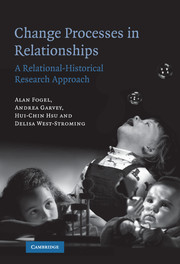Book contents
- Frontmatter
- Contents
- List of figures
- List of tables
- Acknowledgments
- Prologue Overview of the research problem and summary of findings
- 1 Relationships as developing systems: theoretical foundations
- 2 Mother-infant relationship development in the first six months: from face-to-face play to object play
- 3 Relational-historical research on developmental change
- 4 Relational-historical research: the multiple case study approach, frame analysis, qualitative and quantitative analysis
- 5 Research propositions about relationship change processes
- 6 Research methods for the current investigation: subjects, procedures, and data analysis
- 7 Results of the current investigation: quantitative analysis of developmental changes in relationship frames and in infant actions
- 8 Results of the current investigation: qualitative analysis of Richard and his mother
- 9 Results of the current investigation: qualitative analysis of Betsy and her mother
- 10 Results of the current investigation: qualitative analysis of Lewis and his mother
- 11 Results of the current investigation: qualitative analysis of Susan and her mother
- 12 Summary of findings on relational-historical change
- Epilogue Laws of change: implications for theory and practice
- References
- Author index
- Subject index
3 - Relational-historical research on developmental change
Published online by Cambridge University Press: 22 September 2009
- Frontmatter
- Contents
- List of figures
- List of tables
- Acknowledgments
- Prologue Overview of the research problem and summary of findings
- 1 Relationships as developing systems: theoretical foundations
- 2 Mother-infant relationship development in the first six months: from face-to-face play to object play
- 3 Relational-historical research on developmental change
- 4 Relational-historical research: the multiple case study approach, frame analysis, qualitative and quantitative analysis
- 5 Research propositions about relationship change processes
- 6 Research methods for the current investigation: subjects, procedures, and data analysis
- 7 Results of the current investigation: quantitative analysis of developmental changes in relationship frames and in infant actions
- 8 Results of the current investigation: qualitative analysis of Richard and his mother
- 9 Results of the current investigation: qualitative analysis of Betsy and her mother
- 10 Results of the current investigation: qualitative analysis of Lewis and his mother
- 11 Results of the current investigation: qualitative analysis of Susan and her mother
- 12 Summary of findings on relational-historical change
- Epilogue Laws of change: implications for theory and practice
- References
- Author index
- Subject index
Summary
In this chapter we intend to show how interpersonal relationships can be conceptualized as dynamically developing systems. We first define relationships as systems of organized and patterned flows of communicative co-activity called frames. Next, we describe relational-historical research on developmental change, hypothesizing three main processes by which frames re-organize to make way for the emergence of new frames. Finally, we discuss implications of this approach for understanding the developmental transition in the mother-infant relationship from face-to-face to mother-infant-object play.
Relationship frames and transitions
A relationship is a developing communication system encompassing action, physiological processes, and the psychological meaning of those processes to each individual. When we use the word relationship, therefore, we are talking about a living, developing system. Relationships have been observed to move through various phases of development including initial attraction, familiarization, intimacy, commitment, distancing, rejuvenation, and dissolution (Altman & Taylor, 1973; Bowlby, 1969; Gottman et al., 2002; Knapp, 1984; VanLear & Trujillo, 1986). Part of the developmental process is the emergence of new dynamically stable attractors (see Chapter 2) of patterned communicative action called frames.
The ability to identify frames seems to be part of the basic social perceptual abilities with which humans, and most social animals, are endowed. Research on social perception suggests that observers are better at detecting the global aspects of communication than at identifying the precise beginnings and endings of discrete action units (Ginsburg, 1985; Newtson, 1993).
Information
- Type
- Chapter
- Information
- Change Processes in RelationshipsA Relational-Historical Research Approach, pp. 48 - 68Publisher: Cambridge University PressPrint publication year: 2006
